-
 15 min. read
15 min. read
-
 WebFX Team
WebFX Team Digital Marketing Agency
Digital Marketing Agency
- The WebFX team is made up of more than 450 subject matter experts in digital marketing, SEO, web design and web development, social media, and more. Together, they’ve helped WebFX’s clients earn more than $3 billion in revenue from the web — and that’s just in the past five years. @webfx
Wellness programs are one of the largest sweeping reforms in American business history. Because of their popularity, simple implementation, and cost-effectiveness, it’s a challenge to find a company in the US that doesn’t have a wellness program.
Are wellness programs just a fad? Or do they actually have some staying power?
Whether you like wellness programs or hate them, the facts don’t lie — they have real benefits for companies of all sizes. You don’t have to take our word for it, either. Just check out the stats!

The facts on healthcare costs
Before we talk about how wellness programs help, we have to talk about the current state of health in the American workplace.
Poor health alone costs United States companies $1.8 trillion every year. To put that in perspective, that’s the entire GDP of Brazil in 2015. So every year, American companies collectively lose the value of Brazil because of employee health.
On top of that, healthcare expenses can cost some companies up to 50% of their annual profits.
 You also have to consider how Americans work.
You also have to consider how Americans work.
80% of all Americans work in sedentary jobs — otherwise known as an office or white-collar jobs.
78% of workers also describe their jobs as stressful.
The University of Cambridge has documented the effects of stress in the workplace, and nearly all of the effects directly impact a person’s health. In addition, 95% of all medical costs go toward treatment while only 5% go toward prevention. That means the vast majority of employees will wait for a problem to arise before they take care of it.
That type of reactive healthcare literally costs billions every year in America alone. That’s money that you could at least partially save by instituting a wellness program. 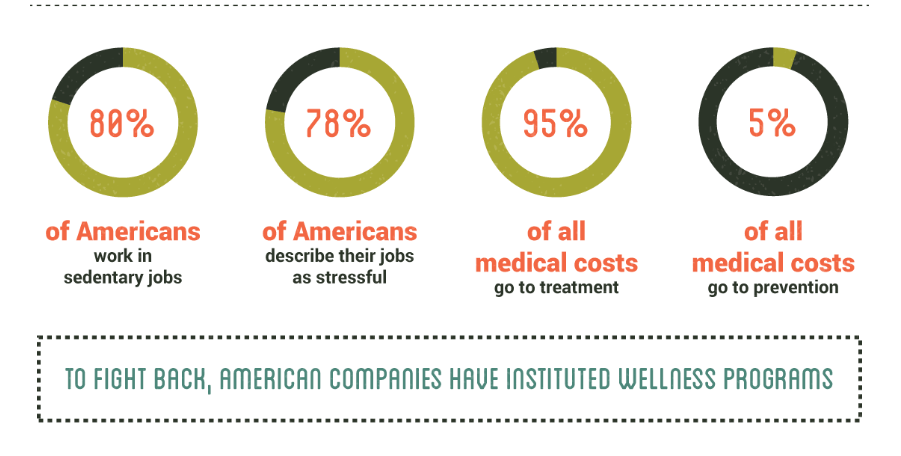 And before you ask — yes, wellness programs do work!
And before you ask — yes, wellness programs do work!
Wellness works
If you want to save money at your company, wellness programs are the way to go.
And we have the stats to prove it!
With a wellness program, you’re investing in employees so they can invest more in your company. It pays off, too. With wellness programs, companies experience an average 30% reduction in workers’ comp and disability claims.
That’s a third of the claims your company receives disappearing each year.
And each one of those claims results in a lot of money and lost productivity for you! On top of that, wellness programs also reduce sick leave by 28% on average.
And in general, they reduce medical costs by 26%. So far, all of these results help your company save money.
With that money, you can hire more people, expand your marketing budget, and grow significantly faster than your current pace. Plus, wellness programs yield an 8% increase in productivity. 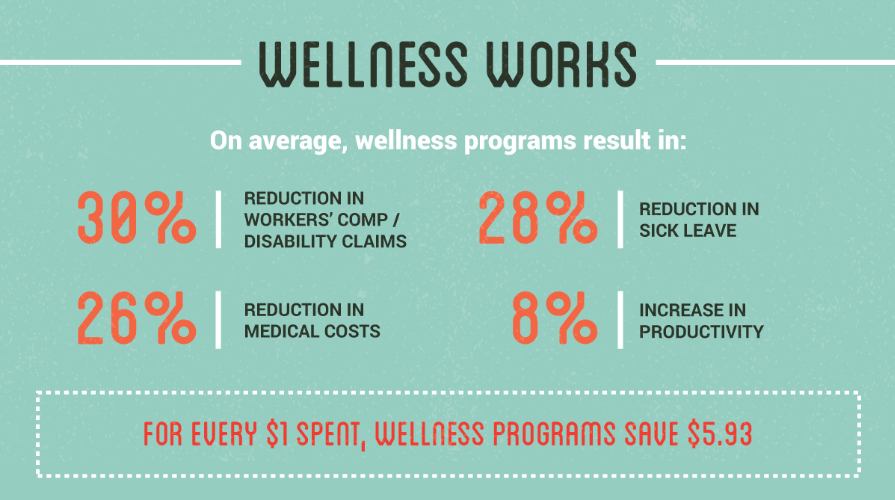 So with all of that money you save — and the increase in productivity — a wellness program almost seems too good to be true.
So with all of that money you save — and the increase in productivity — a wellness program almost seems too good to be true.
But still, that’s not the best part.
. Can you imagine that level of return on a stock portfolio? A mutual fund?
It’d be the most popular fund in the world. With about 10 years of investing, even someone who invested $1 their first year would have $53.7 million in the bank.
That kind of return is absolutely unheard of in the financial world, but wellness programs can achieve it. From a business standpoint, you’d be crazy not to institute a wellness program based on this stat alone.
But wait — there’s more good news!
Whenever you make a change in the workplace, employees’ opinions are always valuable. And in the case of wellness programs, employees’ opinions are almost always favorable.
69% of employees would join an optional wellness program, and 65% say it’s fair to reduce insurance premiums or earn incentives through wellness programs.
On top of that, 45% of employees say a wellness program would keep them at a company. 35% say they’d even be more loyal to a company.
And best yet, 28% of all employees are willing to change their lifestyle habits for lower insurance premiums. What does that mean for managers and executives?
If you want to start a wellness program to save money and increase productivity, you just have to offer employees lower insurance premiums for their dedication to staying healthy.
Talk to your insurance provider. Most of them will let you cut some costs for every employee that signs onto your program. After all, healthier employees means the insurance company won’t have to field as many claims.
That means they won’t need as much money from premiums, so employees can get healthy and save money. And all the while, your company is growing! Employees get more benefits than just insurance premiums, too — they get a longer, healthier life!
Right now, 35.7% of all Americans are obese.
That makes it incredibly important for Americans to stay healthy — especially in the workplace, where physical activity is at a minimum.
Companies that instituted wellness programs saw a 12% increase in healthy weight workers with a 3% reduction in overweight workers and a full 9% reduction in obese workers.
Beyond the shadow of a doubt, that proves that wellness programs don’t just save money — they improve employees’ lives.
By contrast, companies that didn’t introduce wellness programs saw a 2% reduction in healthy weight workers, a 2% reduction in overweight workers, and a 4% increase in obese workers. In other words, companies without wellness programs watched their employees grow more and more unhealthy.
Why wellness matters
In general, wellness programs address many common health issues for employees. Below are four of the most common.
Sodium
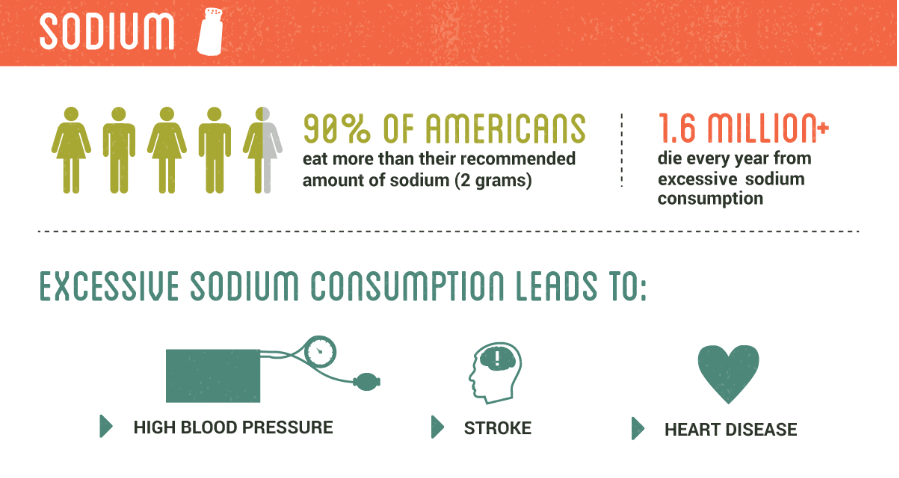
Sodium is an essential part of any diet.
But when you consume it in excess, it can be extremely detrimental to your health. Sodium is half of the ingredients in table salt (the other half is chlorine). Today, salt is on pretty much everything you eat, even salads that you get from restaurants.
It’s the essence of the best savory flavors, and salt can make almost anything taste better — even chocolate.
So it’s no wonder that 90% of Americans eat more than two grams of sodium per day. That’s roughly how much every person should eat, but we all eat more. A Big Mac from McDonald’s alone has 1007 milligrams of sodium.
Their large fries have 291 milligrams, and a large Coca-Cola (30 oz.) has 125 milligrams. Altogether, that’s more than half of your daily sodium in one meal. And it’s one of the most affordable meals in the country.
By setting weight control goals as part of your wellness program, you can help reduce the amount of sodium that employees consume every day.
By extension, you can also reduce their chances of high blood pressure, stroke, and heart disease — three big killers in America right now.
Obesity
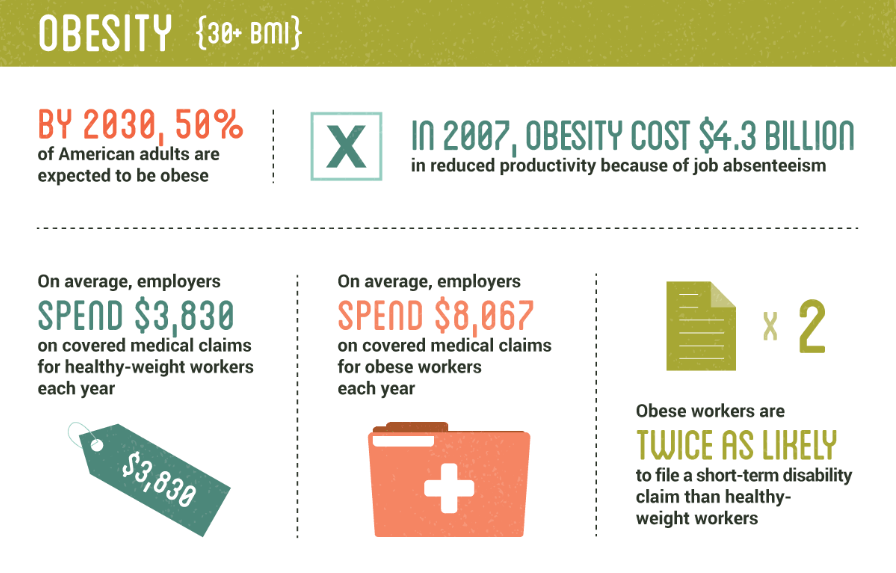
We touched on obesity above, but it bears repeating since it’s such a pressing and sensitive issue in American culture.
Obesity is defined as an excess of body fat, which is roughly 30% or more of someone’s body mass. 50% of Americans are expected to be obese by 2030 — just 14 years from the time of publication.
And in 2007, obesity cost US companies $4.3 billion in reduced productivity, primarily because of job absenteeism. Obese workers cost their employers about $4,200 more in medical costs every year than healthy weight workers.
And obese workers are twice as likely to file short-term disability claims.
But let’s be clear — we’re not talking about cosmetic issues, and none of these statistics are reasons to discriminate against employees at your company. This is about employees’ health. Obesity is strongly tied to heart disease, and heart disease is the #1 cause of death in America.
With that in mind, the bottom line is simple — wellness programs keep employees healthy.
Diabetes

Diabetes is another prevalent issue in American health right now. In 2012, more than a quarter of Americans were pre-diabetic.
That means they weren’t quite diabetic, but they had symptoms of diabetes and could easily acquire it over the coming years. In that same year, almost 10% of Americans actually had diabetes.
Altogether, diabetes can cost companies a lot of money.
The $176 million in direct medical costs is staggering on its own, but that’s just the tip of the iceberg. It’s estimated that diabetes is responsible for $69 billion in reduced productivity. Type 2 diabetes is also tied closely to obesity.
That means you could save employees’ a lot of future stress, pain, and financial hardship by introducing a wellness program that has incentives for achieving and maintaining a healthy weight.
Health in general

With all of that said, wellness programs are also important for health in general. About 20% of workers have had to stop working because of health issues, which may not sound like a lot at first. But that loss of productivity costs companies about $225.8 billion every year.
That’s an incredible amount of money. With that cash back in your hands, your company has the power it needs to grow to new heights — all because you’re looking out for employees.
Smokers and wellness
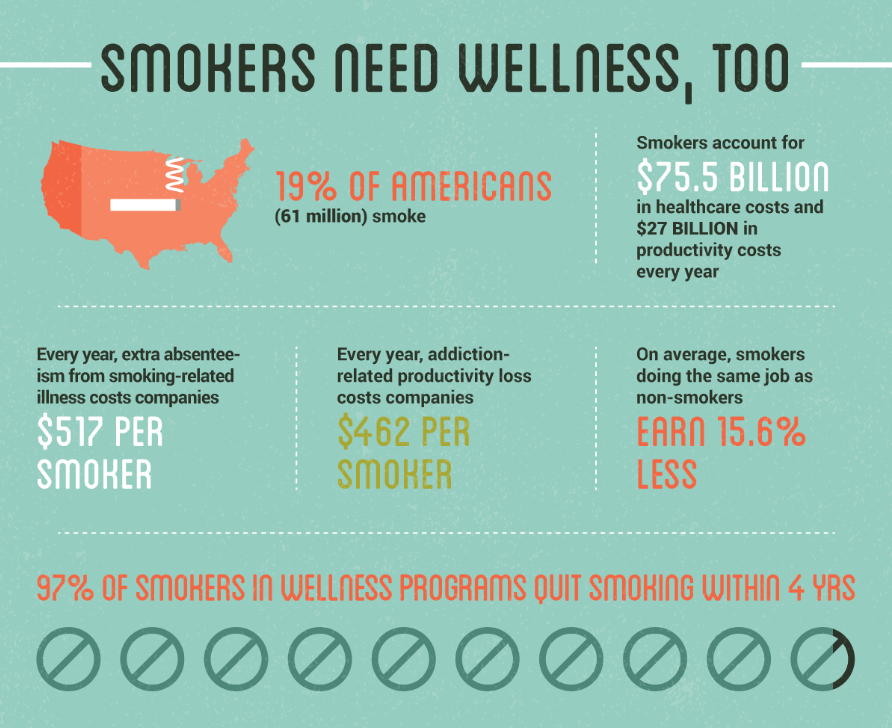 Like obesity, smoking is a sensitive but important issue, particularly in the workplace.
Like obesity, smoking is a sensitive but important issue, particularly in the workplace.
Every American certainly has the right to choose whether they start smoking. But many of them may want to quit later in life after the negative health effects start to set in.
Currently, 19% of Americans smoke.
They account for roughly $75.5 billion in healthcare costs and $27 billion in lost productivity every year. On top of that, smoking-related illness costs companies about $517 per smoker in lost productivity as well.
And addiction-related productivity loss — or “smoke breaks” — costs employers an additional $462 per smoker. Interestingly, smokers also earn about 15.6% less compared to employees who perform the same jobs.
But all of that can change with a wellness program, especially if you offer smoking-related incentives.
In fact, by the end of four years, 97% of smokers in wellness programs quit smoking. It’s always possible that some of employees will remain in the 3% that doesn’t quit. But for the most part, you’ll see a reduction in your expenses.
And employees will at least see improvements in their overall health.
The companies that offer wellness programs
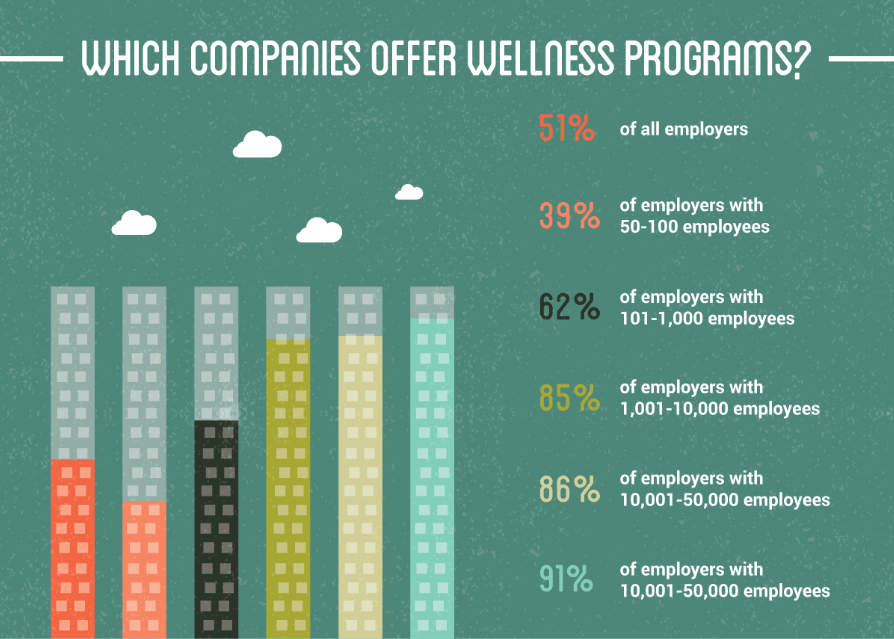
So now that you know how much a wellness program can help, how many companies are actually taking advantage of the benefits? At the time of publication, about half of all employers offer some form of wellness program.
Companies with 50-100 employees have the lowest rate, probably because they don’t have as many workers to worry about. Plus, smaller companies won’t see such sweeping results from a wellness program since they don’t have a lot of employees.
But large companies — like multinational corporations — almost unanimously adopt wellness programs.
These companies will see the biggest benefits of wellness programs because they have the most employees to benefit. But even if you run a small, locally-based company, you can still benefit from a wellness program. In fact, you’ll probably save a few hundred or thousand dollars every year.
That’s still helpful, especially if you’re just starting a company.
And then, every time you hire an employee, you’re enjoying more returns on your wellness program!
The kinds of wellness programs

Not every wellness program is designed exactly the same. What works for one company won’t necessarily work for another 100% of the time. So what kinds of wellness programs are out there?
are two of the most important parts of wellness programs (remember, 95% of medical costs are for prevention).
But for whatever reason, they have the lowest adoption rates. Still, 77% of companies offer lifestyle management programs, and more than half offer fitness benefits. Some even go so far as to offer incentives for healthy foods!
Lifestyle management is another key area of wellness programs.
This area has much higher participation rates than disease prevention, and it includes incentives for fitness, nutrition, not smoking, and more. Some companies offer programs that help employees “get clean” as well. These anti-alcohol and anti-drug programs can help employees cope and grow beyond their addictions.
Incentive programs are also key parts of wellness.
Not every company uses them, but incentives give people tangible reasons to lose weight, stop smoking, or accomplish some other health-related task. Incentives can run the gamut from 10 more minutes for a lunch break to $500 toward a new car. It’s up to you which incentives you choose (if any at all), but they’re great for increasing wellness participation.
Last, some companies offer disease management programs that help people deal with existing health issues.
Those issues include diabetes most often, along with asthma, coronary artery disease, depression, cancer, and even back pain. So now you know how effective wellness programs are, how they benefit your company, how they help employees, and different kinds of programs that companies use. It’s time for the best part — how to start a wellness program for your company!
12 steps to start a wellness program
 You can start a wellness program at your company with 12 simple steps.
You can start a wellness program at your company with 12 simple steps.
Every program starts with an idea.
Create a seed list of ideas for your program and consider whether or not they’re practical at your workplace. You can get ideas from this infographic, searching online, or contacting other companies in your area to see what they do. After you have your ideas narrowed down, you need senior staff support (unless you are senior staff).
An executive or manager writing off on your proposal gives you the foundation you need to proceed. The next step is to survey employees for ideas and interest. Even with your list of approved programs, some employees may have needs of their own.
Others may only join if you offer a few more benefits. Regardless, you need to know that your company’s employees will actually join your program.
Next, you need to get a team together that’s responsible for creating and maintaining the program. It should ideally include you since you created the program in the first place, and you can choose others on a volunteer basis.
You and your team will then assess your company’s needs to make sure you’re hitting all the right areas with your wellness program. But it’s also important to remember that your wellness program needs to follow certain laws pertaining to healthcare information. That includes HIPAA and GINA.
If at any point your wellness program violates these laws, it could be grounds for a lawsuit. But don’t let that scare you away from wellness programs in general — you just need to make sure you’re working by the books.
After that, it’s time to actually design your wellness program. The goal is to create a program that contains the best of your original ideas, your coworkers’ ideas, and any incentives to get people to join.
Sometimes, it may not be possible to get everything you want in one program. That’s okay — it’s important to just get the ball rolling. With your design, you’ll also need a budget.
That will probably be determined by your senior staff supporter or someone on that level. Or it could be you! Regardless, you need to keep your budget in check against what you expect in returns from your insurance company.
Once you have that in place, it’s time to start your wellness program and recruit employees!
As you’re recruiting, you should talk about any incentives that employees can earn by joining and progressing through your wellness program. Those incentives will come in handy when you and your committee follow through and deliver for employees who meet your expectations. Finally, it’s important that you track the program’s monthly and yearly results.
That can include participation, budgeting, money spent, insurance savings, sick day comparisons, overall company output, and more. The more data you have, the better you’ll be able to tell if your wellness program is successful! Although with these statistics, you can bet that it will be.
Does your company have a wellness program?
Does your company have a wellness program?
What’s worked for you? Let us know on Twitter (@WebFX) or Facebook!
-
 The WebFX team is made up of more than 450 subject matter experts in digital marketing, SEO, web design and web development, social media, and more. Together, they’ve helped WebFX’s clients earn more than $3 billion in revenue from the web — and that’s just in the past five years.@webfx
The WebFX team is made up of more than 450 subject matter experts in digital marketing, SEO, web design and web development, social media, and more. Together, they’ve helped WebFX’s clients earn more than $3 billion in revenue from the web — and that’s just in the past five years.@webfx -

WebFX is a full-service marketing agency with 1,100+ client reviews and a 4.9-star rating on Clutch! Find out how our expert team and revenue-accelerating tech can drive results for you! Learn more
The Internet in Real Time
Ever wonder how much is going on at once on the Internet? It can be tough to wrap your mind around it, but we’ve put together a nice visual that’ll help! The numbers show no sign of slowing down either.
Find out More

Ready to Drive Results for Your Business?
See how WebFX uses SEO, PPC, Social Media, and Web Design to Drive Revenue for Businesses.
Get InspiredThe Internet in Real Time
Ever wonder how much is going on at once on the Internet? It can be tough to wrap your mind around it, but we’ve put together a nice visual that’ll help! The numbers show no sign of slowing down either.
Find out More





